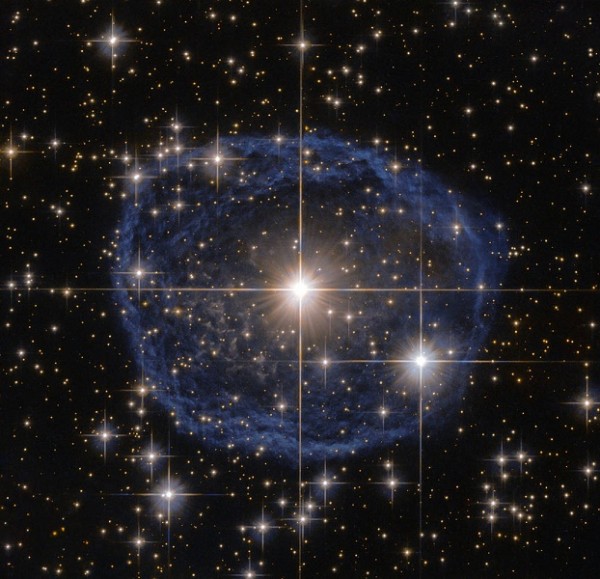By Ana Verayo, | February 29, 2016

The distinctive blue bubble appearing to encircle WR 31a is a Wolf–Rayet nebula — an interstellar cloud of dust, hydrogen, helium and other gases.
An incredible, cosmic blue bubble was captured by NASA's Hubble Space Telescope which is an actual star known as WR 31a that is enshrouded with stellar dust and material, emitting an ethereal glow from the edges of the universe. Astronomers also say that this is also the most detailed photo of the star that was ever obtained.
Like Us on Facebook
The iconic space telescope has been showing many wonders and mysteries of the universe for more than 25 years. These images include star births, supernovae explosions and violent stellar collisions, providing unprecedented views of the cosmos that are never been seen before.
In this latest image, Hubble reveals a mysterious "blue bubble" appearing to be floating in a distant galaxy. This blue bubble can be seen enveloping the Wolf-Rayet star that is located some 30,000 light years away, that is also part of the Carina constellation.
This colossal, cosmic bubble is believed to be made from interstellar dust, hydrogen and helium along with many other gases which are also products of fast moving stellar winds that collided with the hydrogen that are released by Wolf-Rayet stars. The result is this nebulae that appears to be in a ring or spherical shape.
Mission scientists estimate that this bubble was created around 20,000 years ago that is still rapidly expanding at a rate of 136,7000 miles every hour. Astronomers say that this bubble will soon "burst" as this kind of phenomena is short lived, since this type of star is estimated to have a lifespan of 100,000 years, which is a blink of an eye in cosmic standards.
Compared to our parent star, the sun is 20 times smaller which also possesses temperatures of five to 30 times cooler, which is also a million times dimmer than Wolf-Rayet stars. These characteristics indicate that massive, brighter stars live fast and die young as they burn stellar fuel rapidly before dying into a fiery supernova.
These extremely bright, colossal stars such as the Wolf-Rayet stars can lose their mass by up to 50 percent, as opposed to the sun which has been steadily shining brightly for billions of years, yet it is still considered to be in its prime age.
When the WR 31a eventually dies, it will release so much energy as an incredible supernova. This explosion will release essential stellar fuel and elements that can then produce a new generation of stars and even new planets.
-
Use of Coronavirus Pandemic Drones Raises Privacy Concerns: Drones Spread Fear, Local Officials Say

-
Coronavirus Hampers The Delivery Of Lockheed Martin F-35 Stealth Fighters For 2020

-
Instagram Speeds Up Plans to Add Account Memorialization Feature Due to COVID-19 Deaths

-
NASA: Perseverance Plans to Bring 'Mars Rock' to Earth in 2031

-
600 Dead And 3,000 In The Hospital as Iranians Believed Drinking High-Concentrations of Alcohol Can Cure The Coronavirus

-
600 Dead And 3,000 In The Hospital as Iranians Believed Drinking High-Concentrations of Alcohol Can Cure The Coronavirus

-
COVID-19: Doctors, Nurses Use Virtual Reality to Learn New Skills in Treating Coronavirus Patients







